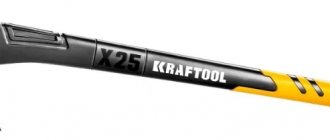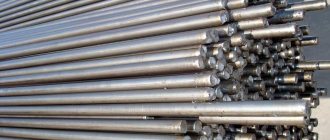An ax is a cutting tool that has been used by man since ancient times. He is known to every person on the planet. Ease of use made it indispensable on hikes, in the countryside and outdoor recreation. Over the course of its existence, it has changed, and now we can see a wide range of models with various blades and handles. Each individual type has its own purpose, shape and size. Found in all cultures of the world, it is used not only as a working tool, but also as a bladed weapon.
Purpose and application
There is no person on the planet who does not know what a simple ax is. The first products that humanity invented were extremely inconvenient, but at that time it was not possible to do without such a tool. With its help they built houses, hunted animals, and obtained branches for fires. Ancient axes often broke, so new ones had to be made. First, people learned to grind the blade, and after several thousand years, copper tips appeared. The prototype of a modern tool appeared only after the discovery of iron, and the purpose of axes became broader. Previously, it was called a chopper, and the handle served as a club. Gradually, the functionality of the products expanded, the heaviest versions became powerful military weapons. They were inexpensive, had high cutting power, which perfectly suited all the requirements of the rebels and the military. Lightweight models were used for household work.
Over the centuries of its existence, this instrument has not changed its name, nor its purpose. An ax is used for chopping. And its type and functionality depend on what exactly it chops. When choosing, you must first consider the weight of the product.
Its weight should not be less than 900 grams if you plan to use the ax for its intended purpose. Small, lightweight models are only suitable for sharpening pegs; they definitely won’t be able to chop wood. Average weight, convenient for the average person, 900-1700 grams. Such a mass is comfortable when working, it is easy to carry with you, it fits comfortably in your hand. A tool of this weight is used in construction and when working with wood. If you need to chop wood (or anything else), you need to choose a heavier ax. The weight of this model is up to 2.5 kg.
The shape of the blade largely depends on where it appears. The cultural heritage of the country where the instrument was used left its mark on the shape of this metal part. The most standard option is carpentry. This ax is made according to GOST, is easy to use and has been produced since the times of the USSR. It is used for wood processing, in construction and many other places. Its shape is universal, allowing you to process logs, boards and any other shapes of wood workpieces. But such a product is not suitable for hiking conditions. A carpenter's ax is not capable of cutting trunks or even branches, especially when the tree comes across a dense species. The so-called Finnish blade successfully copes with this task. Thanks to its rounded shape and a slot at the bottom, the long ax not only chops wood, but also splits it. And the specific sharpening allows it to be used as functionally as possible.
The taiga ax is ideal for dense wood species. The blade differs from previous versions in that the angle of inclination relative to the handle is sharper. This allows it to penetrate the wood better. A lightweight model with the same purpose is called “Deer”. It differs only in its weight of 1 kg versus the taiga one’s weight of 1.5 kg.
Components of an ax
Let's take a closer look at what the tool consists of. In fact, the ax has three components: a blade, a handle and a blade for fixation. The correct name for the handle is axe. And the part called the butt (wedge) connects the blade and the ax handle. The force of the blow depends on the length of the handle. The characteristics of the metal part of the ax affect its integrity during operation. The structure of the product remains the same as it was in the Stone Age. Only the structure of the parts, the fastening scheme and the materials for manufacturing have changed. There are also such elements as a sock, a beard and a cut; they are not present in all models.
Metal head
The metal part of the ax is called the blade. Types of tips:
- Narrow. For working with thin materials, including wooden products.
- Average. Standard parts, used frequently.
- Wide. For those tools that are used for felling forests.
The quality of the steel determines how long the tool will serve its owner. This parameter affects the sharpness, long-term absence of damage and chips. What kind of steel are axes made from?
- Blades for carpentry are made by stamping. Low carbon steel is used.
- Lumberjacks' tools are made by forging (steel grades U7 and 60G). Their density allows you to cut the most resistant trunks, and the blades are easy to sharpen. In ancient times, such metal was used to create axes and battle swords.
Mild steel is not used for manufacturing at all, since it quickly dulls. The hardened one can crumble, so this option is also not suitable.
Toporische
The handle must withstand shock and vibration after it; this part is removable, which means it must be replaced if it breaks. The best material for an ax handle is considered to be birch. This is a light and stable wood that is ideal for chopping work. A bad option would be pine axes. When choosing, you need to focus on ease of use. In the cold season, the handle is wrapped in material so that this part does not slip. Its optimal length is 50-70 cm. A long ax is used for heavy work. Handle materials in modern models vary.
Classification according to the material of the ax
Metal
Externally, the all-metal product looks impressive. Especially if a large ax blade has been picked up. However, metal is not the best solution for an axe. This material does not dampen vibrations from impacts well. If you want to purchase such a tool, preferably handles with attachments (made of rubber or other material), this part improves its quality. But this pen looks beautiful, you can order an individual design.
Plastic
A fairly popular material for an axe, but it has the same drawback as the metal version - it does not absorb the recoil of an impact well. The attachments will help in this case too. Plastic handles, according to the description, are the most fragile parts and require special storage conditions.
Tree
It is considered the best option for an axe. The handle, made of wood, completely absorbs vibrations. This piece of quality wood will be expensive. Pine handles are the cheapest, but do not absorb shock from impact well. Oak axes have proven themselves to be quite good. Wooden handles are lightweight and easy to clean. Replacing them will not be a problem.
Action plan
Drawing up instructions on how to make an ax handle with your own hands allows you to break the process into elementary steps. A compiled list of actions will help you avoid mistakes and improve the quality of the result. This is especially important if you are doing something for the first time.
Note!
We ensure constant availability of hot water. Water heater.- Setting up a table for Easter
- Required distance of the septic tank to the well
The step-by-step process on how to make a pen at home will look like this:
- drawing up a sketch of an ax and a template
- wood processing
- ax attachment
- finishing coating.
Main types of axes
There are several types of axes. They are classified depending on their purpose. This order allows you to decide which of the different types of axes is more suitable for traveling and which to use at home. Some forms are used only in exceptional cases, while others are needed at hand all the time.
Economic
Its most popular use is chopping wood. The sharpening of the blade on a household tool is 50 degrees. Hardened steel and a wooden ax handle are widely used for the ax of this model. They weigh a maximum of 1 kg, are easy to use and perform their functions perfectly.
Carpenter's ax
It is also called carpentry. A tool with straight sharpening, light weight, maximum 900 g. The product size does not exceed 50 cm, has a thin and sharp blade. The carpenter's ax is aimed at tasks in the construction industry, such as turning wood or making grooves in blocks.
Cleaver ax for firewood
Its main difference is its severity. The weight of this product reaches 2-2.5 kg, the handle is up to 80 cm long. This tool does not require sharp sharpening. The largest ax can easily cope with any logs due to its striking force. It is impossible to hold such a huge thing with one hand; working with it requires considerable strength.
Special axes
These varieties are used in exceptional cases; they are not required every day.
For felling forest
The closest relative of the cleaver ax. In terms of functionality, it is distinguished by the additional ability to cut down trees, and not just chop firewood. It has a long handle and a lightweight blade made of high-strength steel. Due to its size, it is heavy; this ax can only be used with two hands.
Double-sided ax
This variety has two sharpened sides on the blade. High-carbon steel is used for special strength of the product. For reliable operation, the ax must be perfectly balanced. Sometimes blades are sharpened differently to suit different situations. This ax was used as a throwing ax, and now it has found its place in construction and installation.
For chopping meat
This is one of the professional tools, usually made entirely of metal. The weight is large to chop meat products quickly, sharpened at an acute angle. The blade is wide, the handle is short, the butcher's tool is convenient to use and does not require much effort.
Marching
This is one of the lightest types in terms of weight, the second name is multitool. Its purpose is to be universal, so it is small in size, easily fits in your belt and does not interfere with walking. Often their blades are rounded so as not to injure the traveler when moving and not to cut things in a tightly packed backpack. The kit always includes a case. With a hatchet you can chop wood and meat, hammer in a peg and peel the bark of a branch.
Tourist
Marching brother. It also has a light weight of up to 600 grams and comes with a protective case. The models are foldable, which simplifies their transportation and saves space in travel luggage. A separate variety is ice axes, used when hiking in the mountains. As part of climbing equipment, compact and lightweight. They have a sharp end on the opposite side of the blade, on the butt to form a hole in the ice.
Firefighter
Axes have been used throughout history to save people. Firefighter models come in belt and assault models. The butt of the instrument, which is stored on the belt, has a sharp protrusion. They break windows and remove locks on doors. With it you can climb up the wall, clinging to the ledges. It comes in black and red, sometimes with yellow splashes. The ax handle of such axes is rubberized to protect your hands from heat. Assault variants are much larger in size, but have an identical shape. They are used during assaults and to remove obstacles. There is a hook on the butt, or it is completely flat. This option is a mandatory component of a fire shield. For safety reasons, they are located in all public places.
Hunting
There are many different types of this type of axe. Used for chopping wood and cutting up carcasses. They do not take up much space, maximum length is 40 cm, weight no more than 750 grams. They consist entirely of metal, with a rubber insert on the handle.
Fit
The next stage in making an ax handle is adjusting the shape and ergonomics. We grind the wood to give it the correct shape and comfortable grip.
A large rasp, as well as a power grinding tool, are perfect for these purposes. The main thing here is not to loosen the place where the ax fits on the ax handle.
Note!
Do-it-yourself garden beds: the best arrangement ideas and step-by-step placement instructions (110 photos)How to clean the grill? Review of the most effective and easy ways to clean a grill in the country
- The best bathroom renovation ideas
How to choose an ax
Before making a choice, you need to determine the purpose of its use. To process wood, you will need a medium-sized ax with a wooden handle. Fans of tourist gatherings need a durable and compact option. A heavy cleaver is suitable for chopping wood. You can start to understand how to choose the right tool by determining the functional accessory:
- for the forest shaft you will need a heavy long ax with a wide blade;
- for household needs, the best choice would be a medium-sized product;
- if point work is required, the functions of a hammer, then a properly selected metal hatchet will help to cope.
Before you finally choose an ax, you need to check the expansion of the eye in the butt. This is important for high-quality wedging of the ax in the upper part of the tool. Next, the symmetry of the blade relative to the handle is checked. Then you need to hang the tool and click on the blade. If the sound is clear and high, it means the hardening is of high quality.
The variety of manufacturers can be confusing when choosing a tool. Finnish companies are considered the best among all. They provide perfect quality products and some companies offer a 10-year warranty. But the price of such manufacturers is not small. Average price segment from manufacturers from Sweden and Germany. And cheap Chinese axes have many complaints; when choosing this option, you need to act responsibly, but it is possible to find a high-quality and inexpensive model.
Service life of the ax
The durability of a homemade ax is measured by the wood's resistance to changes in temperature or humidity, and compressive force. When heavy loads are placed on the upper part of the instrument, the wood bends, crumbles, or even gets wet over time. As a result, the ax begins to wobble, or even the metal chopper completely slips off the ax handle. The service life is affected by the type of wood, degree of drying, frequency of use and method of attachment. The more precise the hammer fit, the longer the tool's service life. If there is a certain gap in the shape of the handle and the metal chopper, then the error can be corrected independently by driving in a special wedge. If you make an ax handle correctly, the product can serve for years, decades without any repairs.
READ How to choose a wood lathe
How to use
If the choice fell on a model with a wooden handle, it must be treated with a special impregnation based on wax, drying oil or linseed oil. They will clog the pores of the ax and prevent moisture and bacteria from entering. For ease of use, the handle is wrapped in rubber. It should be soft so as not to rub your palm.
How to chop correctly:
- For low trees, first remove the branches and tie a cord to the top, tilting it in the direction of fall. They cut down to the middle of the trunk on the side on which the tree should fall. Then cut with a saw.
- Firewood is prepared on a log; first, the branches are removed from the root to the top.
- Logs are cut using a support, which is placed under the impact site. The first blows are vertical, the next blows are at an angle of 40 degrees. Gradually the log is turned, evenly making its way to the core.
- To cut a board, one end is secured, the leg on the work side is placed to the side and slightly back. Cut from top to bottom.
The main thing in all methods is not to forget about safety precautions. If the work is carried out with one hand, the other should be removed from the blow of the ax. The legs are retracted as far as possible if the work is carried out in weight.
Blade
The full size drawing will show the amount of material needed. The blade requires a hard metal, such as a car spring.
We transfer the outline of the drawing to the spring and saw off all the excess. We also make descents using a grinder. It is important here not to overheat the metal so that the edge remains hard and holds an edge well.
Read here: Fences for a summer residence - tips on how to make an inexpensive fence and the best options for building it yourself
Sharpening rules
Devices for these purposes differ in functionality, complexity of use and cost. The machine is more often used by professionals, but an abrasive wheel is suitable for home use. Some types of axes do not require sharpening (cleaver and fireman). The angle for a sharp edge is 20-30 degrees.
Manual method
The easiest way: the abrasive wheel is fixed on the table, the ax blade is held vertically and sharpened on the surface of the wheel with smooth horizontal movements.
Mechanical
You will need protection from chips and metal dust (glasses, thick clothing, mask). The chamfer is covered with a marker, the blade is brought to the sharpening machine at the desired angle. Periodically check whether the marker has been erased. If everything is in order, the product is manually processed with a sharpener. And then they are lubricated with polishing paste and treated with an anti-corrosion agent.










